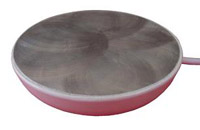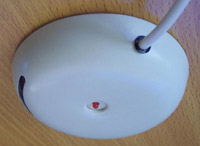|
Reptile lighting
Lighting for a Reptiles EnclosureUltra violet lighting for a reptiles enclosure requires a special form of lighting. Reptile heat lamps are fitted to a reptiles enclosure to supply a heat source for warming up the reptiles environment, terrarium or vivarium. The heat lamps are also used to emit the special light spectrum Ultra violet A and Ultra violet B. This light spectrum is required by reptiles to improve their level of activity, breeding, appetite and general well. Reptile heater lightsReptile heater lights come in many forms. Some heater lamps do not emit (UVA) ultra violet A or (UVB) ultra violet B and both forms of light wave are required for a reptiles health.  Metal halide lamps or mercury vapor lamps that are used to heat and light a terrarium or vivarium should be treated and installed properly and treated with care.
Metal halide lamps or mercury vapor lamps that are used to heat and light a terrarium or vivarium should be treated and installed properly and treated with care.Metal halide lamps for reptile lighting can produce an excess of ultraviolet A which may be harmful to you and your reptile. Manufacturers of some metal halide or mercury vapor lights reduce this (UVA) Ultra Violet A emission by fitting a screening to the lights. This screening can also reduce the amount of beneficial ultraviolet B required by the reptile. Fluorescent lights UV for reptilesNot all forms of fluorescent lights produce the full light spectrum of UV needed by reptiles. The compact spiral type of fluorescent is an example of this. Fish tank and plant fluorescent lights do not emit Ultra Violet B light. Care should be taken when choosing suitable fluorescent lighting for your reptile home.  The life expectancy of most fluorescent lights are from six to twelve months. The lights should be replaced regularly even when the fluorescent lights are still operating and emitting light.
The life expectancy of most fluorescent lights are from six to twelve months. The lights should be replaced regularly even when the fluorescent lights are still operating and emitting light.Reptile lighting is often situated in humid areas. If the humidity of your terrarium, vivarium or reptile enclosure is high, ensure that the fittings for the reptile lighting are water proof and safe. Ultra violet lighting for reptiles are not suitable for heating a terrarium or vivarium. UV lights for reptilesUV lights (ultra violet) should have no plastic, glass, diffuser or acrylic cover over the light source. This type of screening will lower the output of any ultraviolet B ( UVB ).The exception to the use of a screening for an enclosure is for when the lighting is to be used for some species of snakes or pythons. A smooth fine mesh can be used on their reptile lights. Fluorescent lights do not generate any useful heat to warm the terrarium so another source of heating must be introduced to your reptile enclosure, terrarium and vivarium. If a small area is to be heated the use of a hot rock or heat rock is often used. Care should be taken not to position the heat rock close to an existing heater. Heat rocks and other forms of heating can be found at this site. They have a large range of small heaters suitable for warming reptiles. UV lights for reptilesUV for a reptile enclosure, vivarium and terrarium weakens dramatically as the distance is increased between the light source and the floor of your pets habitat. A reasonable distance is about twelve inches (thirty centimeters) from the light source to the floor of the reptile vivarium, terrarium or enclosure. If you decide to double the distance you will decrease the ultraviolet light output by over 70%. Ultra violet lights for reptilesPlacing the Ultra violet lighting for reptiles at the best distance for your reptiles enclosure is important. With proper positioning of the ultra violet lights the maximum output of ultraviolet light will be available for the reptile. Colored lights and reptilesColored lights for reptiles are used by some reptile owners to enhance the appearance of their reptiles. They are also used to provide diffuse lighting in the evenings. The most popular types of colored lights for reptiles are blue and black. These are normal filament lights that have a colored glass coating applied to the inner or outside surface of the glass and the lights operate at a higher wattage. This form of reptile light does not emit the full light spectrum which contains ultraviolet A or ultraviolet B ( UVA UVB ). The operating life of this form of reptile lighting especially some black lights can be very short. If you decide to use this type of light in your terrarium or vivarium consider that a reptiles vision is not the same as a humans vision. When a artificial light source is introduced to the reptiles environment it may cause some distress to the reptile. UV lighting and reptilesThe correct amount of ultraviolet A lighting is important as some reptiles and animals can see more of the UV A range than humans. If this is not correct their perception of colors can be distorted. Another form of lighting for reptiles are under tank lights. They do not display the ultra violet light spectrum but do enhance the display of the reptiles tank. If using the under tank reptile lights another lighting system that emits the UV (ultra violet) light band must still be used. |
 The under tank reptile heater can be used to warm beneath the pets home or position within the enclosure and buried beneath the substrate.
The under tank reptile heater can be used to warm beneath the pets home or position within the enclosure and buried beneath the substrate.